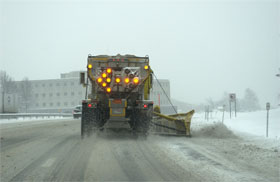Winter Maintenance Program
Overview
Each fall the New York State Thruway Authority (Authority) implements its aggressive winter maintenance program. During periods of inclement winter weather the program’s goal is to provide customers a roadway that is safely driveable at reasonable speeds, with the ultimate goal of returning to bare pavement as quickly as possible.
 Winter preparations begin in the spring with the start of the Authority’s annual preventive maintenance program on all plow trucks and winter maintenance equipment. Further preparations include renewing or establishing salt contracts, procuring needed equipment and supplies, and ensuring a trained and adequately staffed workforce.
Winter preparations begin in the spring with the start of the Authority’s annual preventive maintenance program on all plow trucks and winter maintenance equipment. Further preparations include renewing or establishing salt contracts, procuring needed equipment and supplies, and ensuring a trained and adequately staffed workforce.
The Authority’s four Divisions: New York, Albany, Syracuse and Buffalo are tasked with the operational response to winter weather events. Each of the Authority’s 21 maintenance locations is responsible for snow and ice operations over approximately 30 miles of roadway, as well as the accompanying interchanges, service areas and related facilities. Operations are set to achieve approximately one hour cycle times for plowing and spreading the roadway, although this can vary substantially due to traffic, weather and other factors.
Staffing
Typically, starting in early November all maintenance locations are staffed 24 hours per day during the week with at least three equipment operators per shift. Staffing is gradually increased until the fully staffed portion of the winter begins in early December. At that point, each location has equipment operators scheduled 24/7, including holidays. A supervisor is scheduled on each shift during the week, while the extent of weekend coverage is determined by the weather forecast.
In early March, scheduled staffing is scaled back to five days a week, 24 hours per day. Staffing is gradually reduced until the end of winter maintenance around the beginning of April.
Materials
The Authority’s primary weapon to fight roadway icing is rock salt. The average annual usage for the past ten years is approximately 180,000 tons. The Authority’s 38 storage locations provide for the secure covered storage of approximately 128,100 tons of salt. Sheds are filled prior to the start of winter and salt is reordered as usage occurs throughout the season. With dedicated Authority salt contracts and timely ordering to replenish stockpiles, adequate salt supplies are guaranteed absent the most severe of winters.
In addition to rock salt, the Authority utilizes straight salt brine and a beet brine mixture in both an anti-icing application and as a pre-treatment for the rock salt. Other liquids such as calcium chloride and magnesium chloride are utilized to improve effectiveness at lower temperatures.
Equipment
The Authority has approximately 200 large plow trucks to plow snow and to disperse salt. In addition, each location also has a complement of smaller plow trucks and other ancillary equipment such as front-end loaders and skid steer mounted snowblowers. Every piece of equipment undergoes a thorough preventive maintenance service between each winter season. These efforts are generally completed by late October. By the start of the winter schedule, all material spreaders are mounted on trucks and calibration for proper salt application rates is complete.
The Authority owns five large truck mounted snowblowers. These units are stationed strategically across the system and relocated as forecasts and conditions dictate. In addition, there are 15 smaller skid steer mounted snowblowers that are used for more routine snow removal needs.
Winter Road Treatment and Snow Removal

As mentioned above, the Authority's primary weapon to fight roadway icing is rock salt. The Authority maintains covered storage capacity for approximately 128,100 tons of dry de-icing materials in 38 locations strategically placed along the Thruway. Bulk storage tanks located across the system also provide storage capacity for approximately 100,000 gallons of liquid de-icers.
Pre-treatment of the pavement with liquid de-icing chemicals is also used in some locations in response to a predicted winter storm event. The Authority’s trucks are equipped with automatic spreader control systems that adjust the application rate of de-icing materials to the speed of the vehicle. In addition, many trucks are also equipped with de-icing liquid that can be added to the salt as it is applied to the pavement, increasing effectiveness under certain conditions.
Weather forecasting information from professional meteorological services is also provided to all Authority maintenance sections and the Thruway Statewide Operations Center (TSOC). Field personnel use local resources to fine tune weather forecasts and responses. In addition, there are temperature sensors in each plow truck, in most supervisor vehicles, and at more than 40 locations Thruway-wide that provide pavement temperature and air temperature data to maintenance managers and supervisors. This data is used in conjunction with direct observations, staff reports and weather forecast information to manage snow and ice control operations more effectively.
Travel Resources
- View the Interactive Map which displays information about Traffic Events and Conditions and Winter Traveler Advisories.
- Tune into the Highway Advisory Radio (HAR) Coverage
- Sign-Up for TRANSalerts - electronic traffic alerts
Safety & Emergency
For Emergencies
1-800-842-2233
or 911